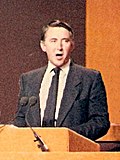| |||||||||||||||||||||||||||||
All 36 metropolitan boroughs, all 296 English districts and all 37 Welsh districts | |||||||||||||||||||||||||||||
|---|---|---|---|---|---|---|---|---|---|---|---|---|---|---|---|---|---|---|---|---|---|---|---|---|---|---|---|---|---|
| |||||||||||||||||||||||||||||
The 1987 United Kingdom local elections were held on Thursday 7 May 1987. [1] [2] [3] It was the first time since 1983 that the Conservatives had enjoyed the largest share of the vote in local council elections.
Contents
Soon after the elections, Prime Minister Margaret Thatcher called a general election which resulted in a second successive Conservative landslide, although Labour managed to cut the government's overall majority, while the Alliance endured another disappointing performance and was soon disbanded as the SDP and Liberals agreed on a merger the following year.
The number of councillors was somewhat reduced from the previous year. The Conservatives lost 75 seats, Labour lost 234 and the Liberal-SDP Alliance gained 669.



